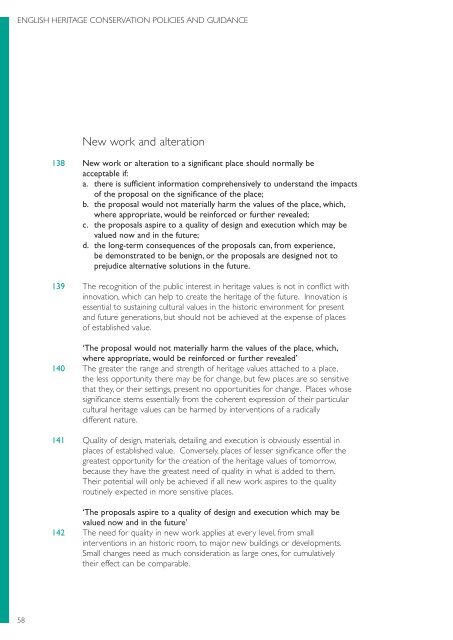Conservation Principles, Policies and Guidance - English Heritage
Conservation Principles, Policies and Guidance - English Heritage
Conservation Principles, Policies and Guidance - English Heritage
You also want an ePaper? Increase the reach of your titles
YUMPU automatically turns print PDFs into web optimized ePapers that Google loves.
ENGLISH HERITAGE CONSERVATION POLICIES AND GUIDANCE<br />
58<br />
New work <strong>and</strong> alteration<br />
138 New work or alteration to a significant place should normally be<br />
acceptable if:<br />
a. there is sufficient information comprehensively to underst<strong>and</strong> the impacts<br />
of the proposal on the significance of the place;<br />
b. the proposal would not materially harm the values of the place, which,<br />
where appropriate, would be reinforced or further revealed;<br />
c. the proposals aspire to a quality of design <strong>and</strong> execution which may be<br />
valued now <strong>and</strong> in the future;<br />
d. the long-term consequences of the proposals can, from experience,<br />
be demonstrated to be benign, or the proposals are designed not to<br />
prejudice alternative solutions in the future.<br />
139 The recognition of the public interest in heritage values is not in conflict with<br />
innovation, which can help to create the heritage of the future. Innovation is<br />
essential to sustaining cultural values in the historic environment for present<br />
<strong>and</strong> future generations, but should not be achieved at the expense of places<br />
of established value.<br />
‘The proposal would not materially harm the values of the place, which,<br />
where appropriate, would be reinforced or further revealed’<br />
140 The greater the range <strong>and</strong> strength of heritage values attached to a place,<br />
the less opportunity there may be for change, but few places are so sensitive<br />
that they, or their settings, present no opportunities for change. Places whose<br />
significance stems essentially from the coherent expression of their particular<br />
cultural heritage values can be harmed by interventions of a radically<br />
different nature.<br />
141 Quality of design, materials, detailing <strong>and</strong> execution is obviously essential in<br />
places of established value. Conversely, places of lesser significance offer the<br />
greatest opportunity for the creation of the heritage values of tomorrow,<br />
because they have the greatest need of quality in what is added to them.<br />
Their potential will only be achieved if all new work aspires to the quality<br />
routinely expected in more sensitive places.<br />
‘The proposals aspire to a quality of design <strong>and</strong> execution which may be<br />
valued now <strong>and</strong> in the future’<br />
142 The need for quality in new work applies at every level, from small<br />
interventions in an historic room, to major new buildings or developments.<br />
Small changes need as much consideration as large ones, for cumulatively<br />
their effect can be comparable.

















